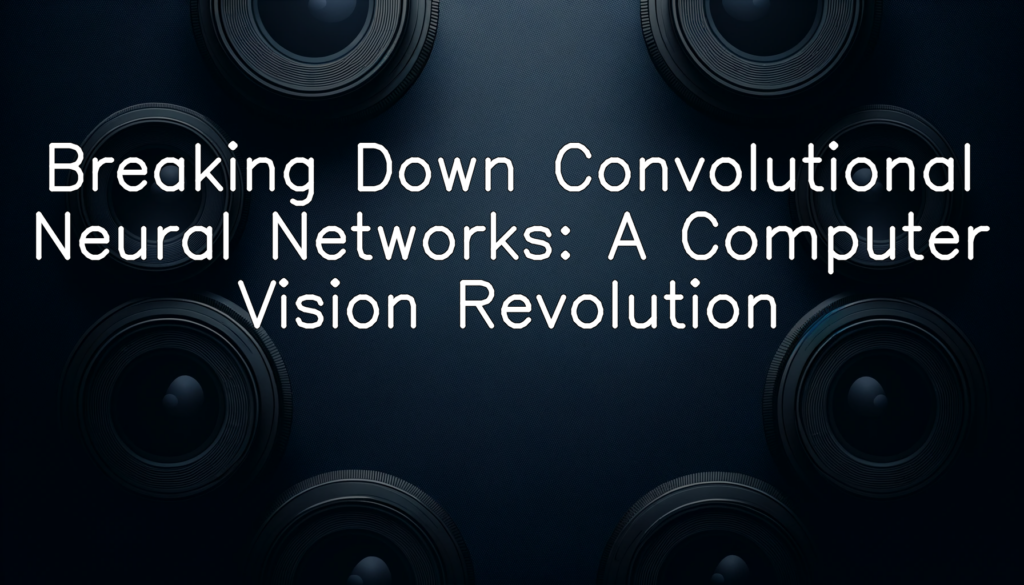Understanding Neural Networks
Neural Networks, specifically in the context of machine learning, work as interconnected web of nodes, often referred to as artificial neurons. These artificial neurons are designed to simulate the functionality of human neurons, making them capable of “learning” from data input. Drawing inspiration from human brain’s own synapse network, these artificial structures allow the processing of complex data types such as images and text, among others. Primarily, the goal of neural networks is to solve complex problems by training on a massive amount of data, gradually adjusting inter-neuron connections, also known as weights, to optimize the accuracy of its outputs. They can identify patterns, trends, and relationships within the processed data, playing a crucial role in applications ranging from predictive analytics to image recognition, natural language processing, and more.
Importance of Convolutional Neural Networks in Computer Vision
Convolutional Neural Networks, or CNNs, have deeply influenced the field of computer vision by providing more accurate and efficient performance in image and video processing tasks. They play a crucial role in enabling computers to view, process, and understand visual data in a similar way to human vision. Particularly useful in spatial data analysis and interpretation, CNNs have greatly enhanced the capabilities of machine learning models in areas such as image and pattern recognition, object detection and segmentation. Their unique architecture, which is different from the conventional neural networks, is designed in a way that automatically and adaptively learns spatial hierarchies of features, thus making them remarkably effective in computer vision tasks. This transformative technology prompts the machines to recognize patterns within images, especially patterns that might be particular to specific objects, thus revolutionizing the field of computer vision technology.
Exploring the Basics of Convolutional Neural Networks
Components of Convolutional Neural Networks
Convolutional Neural Networks (CNNs) consist of several key components that work together synergistically to classify and recognize images. The first element is the convolutional layer which screens the input image for specific features by scanning it through several filters, also known as kernels. This simple operation greatly reduces the complexity by providing a condensed feature map. Next, the pooling or subsampling layer reduces dimensionality and computational complexity even further. It offers different methods, max and average being the most common, to condense the data while holding onto important information. Another critical component is the ReLU (Rectified Linear Unit) layer that introduces non-linearity to the model, allowing it to learn and perform complex tasks. Lastly, the fully connected layer connects all neurons from the preceding layer to the neurons in the current layer, offering a holistic understanding of the image. These components, working together, form the bedrock of a CNN.
How Convolutional Neural Networks Work
Convolutional Neural Networks (CNNs) work on the principle of convolution operation where the input image is processed in small squares or strides. The unique feature about CNNs is their ability to automatically and adaptively learn spatial hierarchies of features from the data. These models are comprised primarily of three types of layers: Convolutional Layer, Pooling Layer, and Fully Connected Layer. The Convolutional Layer accomplishes the heavy lifting of learning local features via kernels. The Pooling Layer, on the other hand, reduces spatial dimensionality, thus offering some degree of translation invariance. Finally, the Fully Connected Layer is where all the learned local features from the previous layers are combined to form the final output. This is the backbone of a Convolutional Neural Network, translating pixels into meaningful insights.
Diving Deeper: The Architecture of Convolutional Neural Networks
Layers in a Convolutional Neural Network
Convolutional Neural Networks (CNNs) utilize a unique architectural structure inspired by the animal visual cortex. This structure typically has multiple different layers, each designed to identify and process different features within an image. The first layer might be dedicated to identifying simple patterns such as edges, while the subsequent layers progressively recognize more complex features, culminating in the final layers that can even identify fully-formed objects. The primary layers in a CNN typically include the input layer, convolutional layer, pooling layer, fully connected layer, and output layer. Each of these layers has a specific role to play in an image’s feature extraction and recognition process, thus allowing a CNN to distinguish and classify a wide range of visuals.
Understanding the Role of Convolution Layer and Pooling Layer
In a Convolutional Neural Network (CNN), the Convolution Layer and Pooling Layer play critical roles in the process of extracting key features from the input data. The Convolution Layer, also known as the feature detector, is responsible for performing a mathematical operation that produces a feature map. This process involves applying a filter or kernel to the input data, sliding the filter across the input, and producing a new matrix (feature map). This map helps the network to learn specific aspects of the input data. The Pooling Layer, on the other hand, is used to reduce the size and complexity of the feature map to prevent overfitting. It does this by summarizing the features in the map, making the network’s computations more manageable and more robust to variations in the input. The most commonly used method is Max Pooling, where the highest value in a region is taken to represent that region. These layers together enable the CNN to understand the input’s key features, thereby assisting in accurate predictions.
Role of Fully Connected Layer and ReLU Layer
The Fully Connected (FC) layer and the Rectified Linear Unit (ReLU) layer both have pivotal roles in Convolutional Neural Networks. The Fully Connected layer, as the name implies, has neurons in the layer that are fully connected to all neurons in the precedent and succeeding layers. It aggregates the outcomes from previous layers and aids in making final predictions based on the object features recognized. On the other hand, ReLU, a type of activation function, introduces non-linearity into the Network’s architecture. The implementation of ReLU helps in handling negative input values, allowing only positive values to pass through. This mechanism helps in decreasing possible problems during the training process and results in faster learning.
Real-World Applications of Convolutional Neural Networks
Convolutional Neural Networks in Image and Video Processing
The power of Convolutional Neural Networks (CNNs) in image and video processing is widely acknowledged in the technological world. Their unique ability to process pixel data and identify unique features in an image or video frame sets them apart from other neural networks. They effectively analyze and categorize visual data to recognize patterns that the human eye might miss. Imagine a scenario where a surveillance system leverages CNNs to analyze video frames and automatically detect any suspicious activities, bringing efficiency and speeding up security operations. In image processing, CNNs have a variety of applications ranging from medical imagery, where they are used to detect anomalies like tumors, to social media platforms where they power image tagging features or filters. All thanks to CNN’s multi-layered processing approach that extracts significant information from raw pixel data.
Role of Convolutional Neural Networks in Self-Driving Cars and Medical Imaging
Convolutional Neural Networks (CNNs) play a significant role in the development and operation of self-driving cars and medical imaging. In self-driving cars, CNNs are integral for the perception modules that enable these autonomous vehicles to view and interpret the world around them. This includes tasks like recognizing pedestrians, identifying traffic signs, and detecting other vehicles. They help make informed decisions based on these interpretations, ultimately influencing the vehicle’s navigational course. In the medical imaging sector, CNNs are revolutionizing the way we detect diseases. They can analyze medical imaging data and effectively identify abnormalities such as tumors, lesions, and other anomalies that might indicate a disease. Consequently, this leads to early diagnosis and a higher chance of efficient and successful treatment.
Convolutional Neural Networks in Face and Object Recognition
The advancements of Convolutional Neural Networks (CNNs) are significantly impacting the area of face and object recognition, both in terms of efficiency and accuracy. CNNs excel in identifying patterns within large and complex data sets, making them quite suitable for tasks like facial recognition where subtle features and details dramatically impact results. Traditional computational methods which rely on manual feature selection process struggle in efficiently detecting minute details such as a tiny mole or a thin eyebrow. But, CNNs can automatically learn and identify these intricate features through several convolutional and pooling layers. Furthermore, in object recognition, CNNs play a pivotal role since they can recognize objects from different angles, lighting conditions and even if the object is partially obscured. These unique capabilities of CNNs have made them indispensable in advanced surveillance systems and biometric access controls, contributing towards a more secure environment.
Conclusion
In the realm of computer vision, the emergence of Convolutional Neural Networks has been nothing short of a revolution. With their unique capabilities in feature detection and image recognition, they’ve permeated multiple sectors from autonomous vehicles to medical imaging and face recognition systems. As technology advances further, these networks are expected to play an even more colossal role, impacting and improving our lives in numerous ways. Amidst an evolving landscape where accurate, real-time decision-making is paramount, their proficiency in handling complex image and video data sets them apart. We’ve only begun to tap into the potential of Convolutional Neural Networks and the promise they hold is beyond inspiring.





